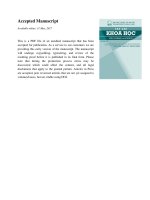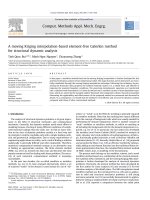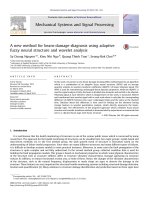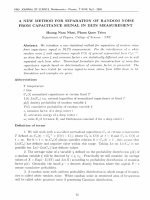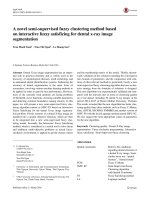DSpace at VNU: A Simple, Effective, Green Method for the Regioselective 3-Acylation of Unprotected Indoles
Bạn đang xem bản rút gọn của tài liệu. Xem và tải ngay bản đầy đủ của tài liệu tại đây (793.32 KB, 16 trang )
Molecules 2015, 20(10), 19605-19619; doi:10.3390/molecules201019605
Article
A Simple, Effective, Green Method for the
Regioselective 3-Acylation of Unprotected
Indoles
Phuong Hoang Tran 1, Hai Ngoc Tran 1, Poul Erik Hansen 2,*, Mai
Hoang Ngoc Do 1 and Thach Ngoc Le 1
1
Department of Organic Chemistry, Faculty of Chemistry, University of
Science, Vietnam National University, Ho Chi Minh City 70000, Vietnam
2
Department of Science, Systems and Models, Roskilde University, POB
260, Roskilde DK-4000, Denmark
*
Author to whom correspondence should be addressed; Tel.: +45-46-742432.
Academic Editor: Jason P. Hallett
Received: 5 October 2015 / Accepted: 22 October 2015 / Published: 27 October
2015
Abstract
: A fast and green method is developed for regioselective acylation of
indoles in the 3-position without the need for protection of the NH
position. The method is based on Friedel-Crafts acylation using acid
anhydrides. The method has been optimized, and Y(OTf) 3 in catalytic
amounts is found to be the best catalyst together with the commercially
available
ionic
liquid
[BMI]BF 4 (1-butyl-3-methylimidazolium
tetrafluoro-borate) as solvent. The reaction is completed in a very short
time using monomode microwave irradiation. The catalyst can be reused
up to four times without significant loss of activity. A range of
substituted indoles are investigated as substrates, and thirteen new
compounds have been synthesized.
Keywords:
Friedel-Crafts acylation; indole derivatives; ionic liquids; metal triflate;
microwave irradiation
1. Introduction
3-Acylindoles are useful intermediates in the synthesis of various
pharmaceuticals [1,2,3,4]. Regioselectivity in the 3-acylation of indoles has
been an interesting and challenging subject in organic synthesis. A wide range
of 3-acylindoles was synthesized by several methods such as Friedel-Crafts
acylation [5,6,7,8,9,10,11,12], Vilsmeier-Haack type reaction [4,13], αaminocarbonyl compounds with palladium [14], carbamoyl electrophiles [2], αoxocarboxylic acids [15,16,17], and nitrilium salt with palladium [18]. Among
those, Friedel-Crafts acylation of free (NH) indoles is definitely the simplest
way [19], however, low yields were observed due to competing substitution at
the 1-position. Therefore, N-acylated and 1,3-diacylated products were obtained,
or indole polymerization may occur in the Friedel-Crafts acylation. To reduce
these side products, NH-protection was necessary [8,20]. The protectiondeprotection steps are not green and convenient methods [21]. Besides,
traditional Lewis acid-catalyzed Friedel-Crafts acylation must be carried out
under strictly anhydrous conditions and requires a greater than stoichiometric
amount of Lewis acid [22]. Aluminum trichloride, a well-known Lewis acid
commonly used in Friedel-Crafts acylations requires a complicated work-up
process and causes environmental problems [22]. The development of
alternative Lewis acid-catalyzed 3-acylations of indoles has been studied
intensively [19]. Among these alternative Lewis acid catalysts, metal triflates
were a good option in various organic reactions [19]. In comparison to
traditional Lewis acids, metal triflate-catalysed Friedel-Crafts acylation does not
require strictly anhydrous conditions due to their water-tolerant characteristics
[23]. Besides, only 1–5 mole % of metal triflate is sufficient for complete
conversion [23]. Furthermore, this can easily be recovered after workup.
Although metal triflates have been applied extensively in Friedel-Crafts
acylation of aromatic compounds [24,25,26,27,28], there has been only one
report on the use of indium triflate for the acylation of indoles [29]. However, in
that case, excess reagent and NH-protection were required to obtain 3-acylated
indoles in good yields. Recently, metal triflates dissolved in ionic liquids were
found to be a good catalytic system in Friedel-Crafts acylations [30]. The
Friedel-Crafts acylation using metal triflate in ionic liquids has been shown to
increase the yield with high regioselectivity and to simplify the recovery of the
catalyst [31,32,33,34,35,36,37].
Microwave-mediated organic synthesis provides a useful method due to
specific interactions and energy efficiency. Microwave irradiation has allowed
the design of efficient processes with significant improvements of yield and
selectivity in a short reaction time and simplification of product purification
[38].
We report here the development of a new method for the Friedel-Crafts 3acylation of indoles with various acid anhydrides using metal triflates in ionic
liquids under microwave activation. In this paper, we are especially interested in
rare-earth metal triflates due to their high catalytic activity and imidazolium
ionic liquids because they are commercially available.
2. Results and Discussion
The first step was to find the best catalyst from among fourteen metal triflates,
including ten rare-earth metal triflates and four well-known triflates such as
bismuth triflate, indium triflate, copper triflate and yttrium triflate. The
acylation of indole with propionic anhydride was chosen as the model reaction.
Indole was treated with 1 mol % of metal triflate in the presence of 1 equiv. of
propionic anhydride under microwave irradiation at 120 °C for 5 min. The
results are presented in Table 1. Among these triflates, yttrium triflate showed
the best catalytic activity for Friedel-Crafts 3-propionylation of indole. Rareearth metal triflates were also efficient (73%–81%), while bismuth and
praseodynium triflates are demonstrated to be less reactive than the others.
Interestingly, direct Friedel-Crafts 3-propionylation of indole gave the desired
3-propionylindole without formation of dipropionylated product and polymers,
and less than 5% of N-propionylated product was found in all cases (with the
exception of bismuth triflate, with 9% N-propionylindole). Yttrium triflate
showed the highest yield and exhibited stronger catalytic activity than the other
metal triflates. This metal triflate has been studied extensively in organic
synthesis in general [39,40,41,42,43,44,45,46,47,48].
Table 1. Effect of metal triflates on Friedel-Crafts propionylation of
indoles
under
microwave
irradiation.
Next, we tested the effect of solvents on Friedel-Crafts propionylation of
indole. The aim of this test was to find the solvent leading to the highest yield
with maximum formation of only 3-propionylindole. Eighteen solvents,
including traditional organic solvents and commercially available ionic liquids,
were investigated. The results are listed in Table 2. The ionic liquid
[BMI]BF4 was found to be the most effective for Friedel-Crafts propionylation
of indole in excellent yield with high regioselectivity, and in this case Npropionylation was completely absent. The result indicates that the presence of
[BMI]BF4 enhances the catalytic activity of yttrium triflate. Friedel-Crafts
acylation using metal triflates in ionic liquids has recently attracted attention
[31,32,33,34,35,36,37,49]. However, this is the first time that tis catalytic
system was applied in the Friedel-Crafts acylation of indoles.
Table 2. Effect of solvents under microwave irradiation (80 °C, 5
min) a.
With optimized conditions in hand, we next investigated the substrate and
reagent scope for the Friedel-Crafts 3-acylation of indoles with acid anhydrides
using yttrium triflate in [BMI]BF 4, and the results are presented in Table 3.
Indole afforded 3-acylindole in excellent yields with high regioselectivity for
the 3-position when using aliphatic acid anhydrides as acylating reagents (Table
3, entries 1–5). Benzoylation of indole gave the desired product in only 78%
yield due to competing N-benzoylation (Table 3, entry 6). For indoles with
electron-rich substituents on the phenyl ring, indoles such as 5-methylindole and
5-methoxyindole, gave 3-acylindoles in yields of 78%–83% without
polymerization or side products. The slightly lower yields of 3-acylated
products are due to increased substitution at the 1- and 2-position (Table 3,
entries 7–18). However, acylation of 4- or 5-haloindoles with aliphatic acid
anhydrides produced 3-acylindoles in good yields (Table 3, entries 19–34). In
addition, N-acylated byproducts were slightly decreased in comparison with
electron-rich indoles, but 2-acylindoles were obtained in small amounts (Table 3,
entries 19–29). A variety of aliphatic acid anhydrides have been tested. Good
yields were obtained for both straight-chain and branched-chain acid anhydrides.
Effects due to steric hindrance do not play a role as pivalic acid anhydride is
also reactive in general (Table 3). The use of microwave irradiation is probably
very important in the case of pivalic acid anhydride as pivaloyl chloride under
Friedel-Crafts conditions are known to lead to decarbonylation [50]. The
reaction has also been tested using conventional heating for 5 min. at 80 °C with
catalyst and in IL. With indole and propionic acid anhydride the yield was 16%
(6/0/94) and with butyric acid anhydride 28% (5/0/95). The regioselectivity was
worse and much longer times are needed. Looking at regioselectivity in general,
it is seen from Table 1 that the catalyst has little influence. From Table 2, most
solvents give good regioselectivity. The exceptions are acetone and [BMI]SCN.
It is hard to find a common factor for those conditions. It can be added that
using propionic anhydride with indole gave a ratio of 7/93 but only in 20% yield
in the absence of catalyst. From Table 3, it is seen that pivalic acid anhydride
and 2-methylpropionic acid anhydride give rise to more 2-substitution than
straight chain acid anhydrides and so does benzoic acid anhydride. A
comparison of entries 23 and 34 shows that the reason is not purely steric. More
important seems to be the nature of the substitutent in the 5-position. As the
three mentioned acylium ions are more stable than those of straight chain
acylium ions, it appears that a higher yield of the 2-isomer is caused by a
combination of a small steric effect, electronic influence of the 5-position and
the stability of the acylium ion.
Table
3. Friedel-Crafts
Y(OTf)3/[BMI]BF4 under
irradiation a.
acylation
of
monomode
indoles
using
microwave
The reusability of Y(OTf) 3/[BMI]BF4 was also studied. After the first use, the
recovered catalytic system was tested in four consecutive runs without
significant loss of catalytic activity in propionylation of indole and 5bromoindole (Scheme 1). The recovery of yttrium triflate in [BMI]BF 4 is simple.
After workup, the ionic liquid containing metal triflate is dried under vacuum
before the next use.
Scheme 1. Recycling of Y(OTf) 3/[BMI]BF4 in four consecutive runs under
microwave irradiation.
3. Experimental Section
3.1. Chemicals and Supplies
Indoles, acid anhydrides and metal triflates were purchased from SigmaAldrich (St. Louis, MO, USA) and immediately used without further
purification. Solvents were obtained from Labscan (Bangkok, Thailand) and
Chemsol (Hochiminhcity, Vietnam) and also directly used without purification.
Silica gel was from Merck (Darmstadt, Germany).
3.2. Instruments
Microwave irradiation was performed in a CEM Discover BenchMate
apparatus (Matthews, NC, USA) which allows microwave synthesis with safe
pressure regulation using a 10 mL pressurized glass tube with Teflon-coated
septum and vertically-focused IR temperature sensor controlling reaction
temperature. Flash column chromatography was performed on silica gel
(Merck). GC-MS analyses were performed on an Agilent GC System 7890
(Santa Clara, CA, USA) equipped with an Agilent 5973N mass selective
detector and a DB-5MS capillary column (30 m × 250 µm × 0.25 µm). The 1Hand 13C-NMR spectra were recorded on an Advance 500 (Bruker, Rheinstetten,
Germany) and Mercury 300 (Varian, Palo Alto, CA, USA) instrument using
DMSO-d6 or CDCl3 as solvent and solvent peaks or TMS as internal standards.
HRMS (ESI) data were recorded on Bruker micrOTOF-QII MS (Bruker,
Bremen, Germany) at 80 eV.
3.3. Acylation Procedure
A 10 mL glass vessel suited for the monomode microwave oven was charged
with 1 mmol substrate, 1 mmol acid anhydride, 0.01 mmol metal triflate, and 1
mmol ionic liquid. Next, the vessel was sealed with a Teflon cap and irradiated
in a monomode microwave oven at many different reaction conditions
(temperature and time) to find the optimal condition. Upon completion, the
vessel was cooled down to room temperature and the mixture was extracted
with Et2O (5 × 10 mL). The ether layer was decanted and washed with water (2
× 10 mL), saturated aqueous NaHCO3 (2 × 20 mL), and brine (2 × 10 mL). The
organic layer was dried over MgSO 4, filtered, and the solvent was removed by a
rotary evaporator. The isolated yield was determined after purification by flash
chromatography (silica gel, n-hexane/ethyl acetate, gradient 10:0 to 8:2).
3.4. Recovery and Reuse of the Catalytic System Y(OTf) 3/[BMI]BF4
This procedure was also carried out in the monomode microwave oven using
indole or 5-bromoindole. In order to recover the catalytic
Y(OTf)3/[BMI]BF4 system after completion of the reaction, diethyl ether was
applied to wash the reaction mixture as many times as necessary to completely
remove both substrates and products. Then, the mixture Y(OTf) 3/[BMI]BF4 was
dried in vacuum at 80 °C for 30 min. Due to its high solubility in the ionic
liquid [BMI]BF4, Y(OTf)3could easily be recovered in a quantitative yield. This
recycled system was used for four consecutive runs and it can be noticed that
the isolated yield of product only decreased slightly after each run. The process
for recycling Y(OTf) 3 in [BMI]BF4 is simple and efficient so it easily can be
applied on a large scale.
3.5. Compounds
New compounds have been synthesized as follows:
3-Propionyl-5-Methylindole
Pale yellow solid, mp. 208–209 °C. 1H-NMR (300 MHz, DMSO-d6): δ 11.75
(br s, 1H), 8.23 (s, 1H), 8.04–7.93 (m, 1H), 7.33 (d, J = 8.3 Hz, 1H), 7.02
(dd, J = 8.3, 1.5 Hz, 1H), 2.84 (q, J = 7.4 Hz, 2H), 2.39 (s, 3H), 1.10 (t, J = 7.4
Hz, 3H). 13C-NMR (75 MHz, DMSO-d6): δ 195.7, 134.9, 133.4, 130.3, 125.7,
124.1, 121.0, 115.6, 111.6, 31.8, 21.3, 9.2. GC-MS (EI, 70 eV): m/z (%) = 187
(25, [M+]). HR-ESI-MS m/z calcd. for ([M + Na] +) 210.0889, found 210.0917.
3-Butyryl-5-methylindole
Pale yellow solid, mp. 190–191 °C. 1H-NMR (300 MHz, DMSO-d6) δ 11.75
(br s, 1H), 8.26–8.22 (m, 1H), 8.00 (d, J = 2.0 Hz, 1H), 7.30 (s, 1H), 7.01 (s,
1H), 2.77 (t, J = 7.3 Hz, 2H), 2.37 (s, 3H), 1.64 (sext, J = 7.4 Hz, 2H), 0.91
(t, J = 7.4 Hz, 3H). 13C-NMR (75 MHz, DMSO-d6) δ 195.2, 134.9, 133.6,
130.2, 125.6, 124.0, 121.1, 116.1, 111.6, 35.7, 18.3, 13.8. GC-MS (EI, 70
eV): m/z (%) = 201 (25, [M+]). HR-ESI-MS: m/z calcd. for ([M + Na] +)
224.1046, found 224.1053.
3-Isobutyryl-5-methylindole
Pale yellow solid, mp. 210–211 °C. 1H-NMR (300 MHz, DMSO-d6): δ 11.76
(br s, 1H), 8.26 (d, J = 3.1 Hz, 1H), 8.00 (s, 1H), 7.31 (d, J = 8.3 Hz, 1H),
7.00 (dd, J = 8.3, 1.6 Hz, 1H), 3.41 (hept, J = 6.8 Hz, 1H), 2.37 (s, 3H), 1.09
(d, J = 6.8 Hz, 6H). 13C-NMR (75 MHz, DMSO-d6): δ 199.3, 135.0, 133.4,
130.3, 126.0, 124.1, 121.2, 114.6, 111.6, 35.7, 21.3, 19.8. GC-MS (EI, 70
eV): m/z (%) = 201 (25, [M+]). HR-ESI-MS: m/z calcd. for ([M + Na] +)
224.1046, found 224.1063.
3-Propionyl-5-methoxyindole
White solid, mp. 182–183 °C. 1H-NMR (300 MHz, DMSO-d6): δ 11.74 (br s,
1H), 8.21 (s, 1H), 7.69 (d, J = 2.5 Hz, 1H), 7.33 (d, J = 8.8 Hz, 1H), 6.81
(dd, J = 8.8, 2.6 Hz, 1H), 3.75 (s, 3H), 2.82 (q, J = 7.4 Hz, 2H), 1.09 (t, J = 7.4
Hz, 3H). 13C-NMR (75 MHz, DMSO-d6): δ 195.7, 155.3, 133.6, 131.4, 126.1,
115.8, 112.7, 112. 103.0, 55.2, 31.7, 9.1. GC–MS (EI, 70 eV): m/z (%) = 203
(25, [M+]). HR-ESI-MS: m/z calcd. for ([M + Na] +) 226.0839, found 226.0856.
3-Butyryl-5-methoxyindole
White solid, mp. 166–167 °C. 1H-NMR (300 MHz, DMSO-d6): δ 11.77 (s,
1H), 8.24 (s, 1H), 7.72 (d, J = 2.5 Hz, 1H), 7.34 (d, J = 8.8 Hz, 1H), 6.83
(dd, J = 8.8, 2.6 Hz, 1H), 3.77 (s, 3H), 2.79 (t, J = 7.4 Hz, 2H), 1.66 (sext, J =
7.4 Hz, 2H), 0.94 (t, J = 7.4 Hz, 3H). 13C-NMR (75 MHz, DMSO-d6): δ 195.2,
155.3, 133.8, 131.4, 126.1, 116.3, 112.7, 112.6, 103.0, 55.2, 40.5, 18.3, 13.9.
GC–MS (EI, 70 eV): m/z (%) = 217 (25, [M+]). HR-ESI-MS: m/z calcd. for
([M + Na]+) 240.0995, found 240.1026.
3-Isobutyryl-5-methoxyindole
White solid, mp. 158–159 °C. 1H-NMR (500 MHz, CDCl3): δ 8.77 (br s,
1H), 7.97 (d, J = 2.5 Hz, 1H), 7.85 (d, J = 3.0 Hz, 1H), 7.29 (d, J = 8.8 Hz,
1H), 6.92 (dd, J = 8.8, 2.5 Hz, 1H), 3.87 (s, 3H), 3.33 (hept, J = 6.8 Hz, 1H),
1.27 (d, J = 6.8 Hz, 7H). 13C-NMR (125 MHz, CDCl3): δ 201.1, 156.4, 131.3,
131.0, 126.7, 116.6, 114.4, 112.1, 103.6, 55.7, 37.1, 19.8. GC-MS (EI, 70
eV): m/z (%) = 217 (25, [M+]). HR-ESI-MS: m/z calcd. for ([M + Na] +)
240.0995, found 240.1035.
3-Pivaloyl-5-methoxyindole
White solid, mp. 153–154 °C. 1H-NMR (300 MHz, DMSO-d6): δ 11.74 (s,
1H), 8.29 (d, J = 1.9 Hz, 1H), 7.84 (d, J = 2.5 Hz, 1H), 7.33 (d, J = 8.8 Hz,
1H), 6.81 (dd, J = 8.8, 2.6 Hz, 1H), 3.77 (s, 3H), 1.33 (s, 9H). 13C-NMR (75
MHz, DMSO-d6): δ 201.5, 155.7, 133.1, 131.0, 128.4, 113.0, 112.8, 112.5,
104.1, 55.6, 43.8, 29.1. GC-MS (EI, 70 eV): m/z (%) = 231 (15, [M+]). HRESI-MS: m/z calcd. for ([M + Na] +) 254.1152, found 254.1189.
3-Isobutyryl-5-bromoindole
White solid, mp. 223–224 °C. 1H-NMR (300 MHz, DMSO-d6): δ 12.11 (br s,
1H), 8.42 (s, 1H), 8.35 (dd, J = 2.0, 0.5 Hz, 1H), 7.44 (dd, J = 8.6, 0.5 Hz,
1H), 7.33 (dd, J = 8.6, 2.0 Hz, 1H), 3.44 (hept, J = 6.8 Hz, 1H), 1.12 (d, J =
6.8 Hz, 6H). 13C-NMR (75 MHz, DMSO-d6): δ 199.5, 135.4, 134.7, 127.5,
125.3, 123.6, 114.4, 114.4, 114.1, 35.8, 19.7. GC-MS (EI, 70 eV): m/z (%) =
265 (25, [M+]). HR-ESI-MS: m/z calcd. for ([M + Na] +) 287.9994, found
288.0006.
3-Pivaloyl-5-bromoindole
White solid, mp. 234–235 °C. 1H-NMR (300 MHz, DMSO-d6): δ 12.04 (br s,
1H), 8.42 (dd, J = 2.0, 0.5 Hz, 1H), 8.40 (s, 1H), 7.41 (dd, J = 8.6, 0.5 Hz,
1H), 7.30 (dd, J = 8.6, 2.0 Hz, 1H), 1.31 (s, 9H). 13C-NMR (75 MHz, DMSOd6): δ 201.1, 134.3, 133.6, 128.9, 125.0, 124.1, 114.2, 113.7, 111.6, 43.3, 28.3.
GC-MS (EI, 70 eV): m/z (%) = 279 (15, [M+]). HR-ESI-MS: m/z calcd. for
([M + Na]+) 302.0151, found 302.0186.
3-Butyryl-5-chloroindole
Pale yellow solid, mp. 214–215 °C. 1H-NMR (500 MHz, CDCl3): δ 8.60 (br
s, 1H), 8.42 (d, J = 2.0 Hz, 1H), 7.87 (d, J = 2.9 Hz, 1H), 7.33 (d, J = 8.6 Hz,
1H), 7.24 (J = 8.7, 2.1 Hz, 1H), 2.83 (t, J = 7.4 Hz, 2H), 1.81 (sext, J = 7.4 Hz,
2H), 1.03 (t, J = 7.4 Hz, 3H). 13C-NMR (125 MHz, CDCl3): δ 196.1, 134.6,
131.5, 130.2, 126.6, 124.2, 122.2, 118.1, 112.2, 41.8, 18.4, 14.0. GC-MS (EI,
70 eV): m/z (%) = 221 (25, [M+]). HR-ESI-MS: m/z calcd. for ([M + Na] +)
244.0499, found 244.0472.
3-Isobutyryl-5-chloroindole
Pale yellow solid, mp. 198–199 °C. 1H-NMR (500 MHz, CDCl3): δ 8.66 (br
s, 1H), 8.44 (d, J = 2.0 Hz, 1H), 7.89 (d, J = 2.7 Hz, 1H), 7.33 (d, J = 8.6 Hz,
1H), 7.24 (dd, J = 8.7, 2.4 Hz, 1H), 3.31 (hept, J = 6.8 Hz, 1H), 1.26 (d, J =
6.8 Hz, 6H). 13C-NMR (125 MHz, CDCl3): δ 200.4, 134.7, 131.4, 128.6, 127.0,
124.2, 122.3, 116.7, 112.2, 37.3, 19.6. GC-MS (EI, 70 eV): m/z (%) = 221 (25,
[M+]). HR-ESI-MS: m/z calcd. for ([M + Na] +) 244.0499, found 244.0537.
3-Propionyl-4-bromoindole
Reddish brown solid, mp. 112–113 °C. 1H-NMR (500 MHz, CDCl3): δ 9.59
(br s, 1H), 7.40 (dt, J = 8.3, 0.8 Hz, 1H), 7.33 (dd, J = 7.5, 0.7 Hz, 1H), 7.24
(dd, J = 2.3, 0.9 Hz, 1H), 7.19 (dd, J = 8.2, 7.6 Hz, 1H), 3.04 (q, J = 7.4 Hz,
2H), 1.30 (t, J = 7.4 Hz, 3H). 13C-NMR (125 MHz, CDCl3): δ 194.1, 137.4,
135.0, 128.5, 126.8, 123.8, 116.8, 111.5, 108.9, 31.6, 8.6. GC-MS (EI, 70
eV): m/z (%) = 251 (70, [M+]). HR-ESI-MS: m/z calcd. for ([M + Na] +)
273.9838, found 273.9814.
3-Pivaloyl-4-bromoindole
Pale yellow solid, mp = 154 °C. 1H-NMR (500 MHz, CDCl3): δ 9.37 (br s,
1H), 7.37 (d, J = 8.3 Hz, 1H), 7.32 (dd, J = 7.5, 0.6 Hz, 1H), 7.25 (dd, J = 2.3,
0.9 Hz, 1H), 7.17 (dd, J = 8.2, 7.6 Hz, 1H), 1.48 (s, 9H). 13C-NMR (125 MHz,
CDCl3): δ 199.0, 136.1, 132.4, 128.7, 126.6, 123.7, 116.8, 111.2, 108.8, 43.5,
28.4. GC-MS (EI, 70 eV): m/z (%) = 279 (40, [M+]). HR-ESI-MS: m/z calcd
for ([M + Na] +) 302.0151, found 302.0189.
4. Conclusions
In summary, a new catalytic system Y(OTf) 3/[BMI]BF4 has been developed
for 3-acylation of indoles using acid anhydrides under monomode microwave
irradiation. This is a simple, straightforward and environmentally benign
method to prepare 3-acylindoles in high yields, high regioselectivity and in
short reaction times.
Acknowledgments
We thank Duy Khiem Nguyen Chau (University of Minnesota Duluth, Duluth,
MN, USA) for helpful discussions.
Author Contributions
P. H. Tran, H. N. Tran designed and performed the experiments; P. E. Hansen
and M. H. N. Do analyzed the spectra and data; P. H. Tran, P. E. Hansen and T.
N. Le wrote the paper.
Conflicts of Interest
The authors declare no conflict of interest.
1.
References
Alvarez-Builla, J.; Vaquero, J.J.; Barluenga, J. Modern Heterocyclic Chemistry;
Wiley-VCH: Weinheim, Germany, 2011; Volume 4, pp. 377–532. [Google
Scholar]
2.
3.
4.
5.
6.
7.
8.
9.
10.
11.
12.
13.
14.
15.
Velavan, A.; Sumathi, S.; Balasubramanian, K.K. AlMe 3-mediated regio- and
chemoselective reactions of indole with carbamoyl electrophiles. Eur. J. Org.
Chem. 2013, 3148–3157. [Google Scholar] [CrossRef]
Zhang, P.; Xiao, T.; Xiong, S.; Dong, X.; Zhou, L. Synthesis of 3-acylindoles
by visible-light induced intramolecular oxidative cyclization of oalkynylated N,N-dialkylamines. Org. Lett. 2014, 16, 3264–3267. [Google
Scholar] [CrossRef] [PubMed]
Che, Z.; Zhang, S.; Shao, Y.; Fan, L.; Xu, H.; Yu, X.; Zhi, X.; Yao, X.; Zhang,
R. Synthesis and quantitative structure-activity relationship (QSAR) study of
novel N-arylsulfonyl-3-acylindole arylcarbonyl hydrazone derivatives as
nematicidal agents. J. Agric. Food. Chem. 2013, 61, 5696–5705. [Google
Scholar] [CrossRef] [PubMed]
Ottoni, O.; Neder, A.D.F.; Dias, A.K.B.; Cruz, R.P.A.; Aquino, L.B. Acylation
of indole under Friedel-Crafts conditions—An improved method to obtain 3acylindoles regioselectively. Org. Lett. 2001, 3, 1005–1007. [Google Scholar]
[CrossRef] [PubMed]
Stalick, W.M.; Wynne, J.H.; Lloyd, C.T.; Jensen, S.D.; Boson, S. 3-Acylindoles
via a One-Pot, Regioselective Friedel-Crafts reaction. Synthesis 2004, 2277–
2282. [Google Scholar] [CrossRef]
Lin, H.; Sun, X.W. Highly efficient synthesis of 3-indolyl-substituted phthalides
via Friedel-Crafts reactions in water. Tetrahedron Lett. 2008, 49, 5343–5346.
[Google Scholar] [CrossRef]
Metwally, M.A.; Shaaban, S.; Abdel-Wahab, B.F.; El-Hiti, G.A. 3Acetylindoles: Synthesis, reactions and biological activities. Curr. Org.
Chem. 2009, 13, 1475–1496. [Google Scholar] [CrossRef]
Guchhait, S.K.; Kashyap, M.; Kamble, H. ZrCl4-mediated regio- and
chemoselective Friedel-Crafts acylation of indole. J. Org. Chem. 2011, 76,
4753–4758. [Google Scholar] [CrossRef] [PubMed]
Bai, G.; Li, T.; Yang, Y.; Zhang, H.; Lan, X.; Li, F.; Han, J.; Ma, Z.; Chen, Q.;
Chen, G. Microwave-assisted Friedel-Crafts acylation of indole with acetic
anhydride over tungstophosphoric acid modified Hβ zeolite. Catal.
Commun.2012, 29, 114–117. [Google Scholar] [CrossRef]
Zhang, L.R.; Yi, F.P.; Zou, J.Z.; Zhang, X.; Wang, Z. Regioselective FriedelCrafts acylation of indoles catalysed by zinc oxide in an ionic liquid. J. Chem.
Res. 2012, 36, 600–602. [Google Scholar] [CrossRef]
Lai, Q.Y.; Liao, R.S.; Wu, S.Y.; Zhang, J.X.; Duan, X.H. A novel microwaveirradiated solvent-free 3-acylation of indoles on alumina. New J.
Chem. 2013, 37, 4069–4076. [Google Scholar] [CrossRef]
Chatterjee, A.; Biswas, K.M. Acylation of indoles by Duff reaction and
Vilsmeier-Haack formylation and conformation of N-formylindoles. J. Org.
Chem. 1973, 38, 4002–4004. [Google Scholar] [CrossRef]
Tang, R.Y.; Guo, X.K.; Xiang, J.N.; Li, J.H. Palladium-catalyzed synthesis of 3acylated indoles involving oxidative cross-coupling of indoles with alpha-amino
carbonyl compounds. J. Org. Chem. 2013, 78, 11163–11171. [Google Scholar]
[CrossRef] [PubMed]
Yu, L.; Li, P.; Wang, L. Copper-promoted decarboxylative direct C3-acylation
of N-substituted
indoles
with
alpha-oxocarboxylic
acids. Chem.
Commun. 2013, 49, 2368–2370. [Google Scholar] [CrossRef] [PubMed]
16. Gu, L.J.; Liu, J.Y.; Zhang, L.Z.; Xiong, Y.; Wang, R. Synthesis of 3-acylindoles
via decarboxylative cross-coupling reaction of free (N-H) indoles with αoxocarboxylic acids. Chin. Chem. Lett. 2014, 25, 90–92. [Google Scholar]
[CrossRef]
17. Wang, C.; Wang, S.; Li, H.; Yan, J.; Chi, H.; Chen, X.; Zhang, Z. Coppercatalyzed decarboxylative C3-acylation of free (N-H) indoles with alphaoxocarboxylic acids. Org. Biomol. Chem. 2014, 12, 1721–1724. [Google
Scholar] [CrossRef] [PubMed]
18. Jiang, T.S.; Wang, G.W. Synthesis of 3-acylindoles by palladium-catalyzed
acylation of free (N-H) indoles with nitriles. Org. Lett. 2013, 15, 788–791.
[Google Scholar] [CrossRef] [PubMed]
19. Sartori, G.; Maggi, R. Advances in Friedel-Crafts Acylation Reactions:
Catalytic and Green Processes; Taylor & Francis: Boca Raton, FL, USA, 2010.
[Google Scholar]
20. Ketcha, D.M.; Gribble, G.W. A convenient synthesis of 3-acylindoles via
Friedel-Crafts acylation of 1-(pheny1sulfonyl)indole. A new route to
pyridocarbazole-5,11-quinones and Ellipticine. J. Org. Chem. 1985, 50, 5451–
5457. [Google Scholar] [CrossRef]
21. Wuts, P.G.M.; Greene, T.W. Greene’s Protective Groups in Organic Synthesis,
4th ed.; John Wiley & Sons: Hoboken, NJ, USA, 2007. [Google Scholar]
22. Olah, G.A. Friedel-Crafts Chemistry; John Wiley and Sons: New York, NY,
USA, 1973. [Google Scholar]
23. Kobayashi, S.; Sugiura, M.; Kitagawa, H.; Lam, W.W.L. Rare-earth metal
triflates in organic synthesis. Chem. Rev.2002, 102, 2227–2302. [Google
Scholar] [CrossRef] [PubMed]
24. Prakash, G.K.S.; Mathew, T.; Olah, G.A. Gallium(III) triflate: An efficient and
a sustainable Lewis acid catalyst for organic synthetic transformations. Acc.
Chem. Res. 2012, 45, 565–577. [Google Scholar] [CrossRef] [PubMed]
25. Balaguer, A.; Selhorst, R.; Turnbull, K. Metal triflate-catalyzed Friedel-Crafts
acetylation of 3-phenylsydnone. Synth. Commun. 2013, 43, 1626–1632. [Google
Scholar] [CrossRef]
26. Perrier, A.; Keller, M.; Caminade, A.M.; Majoral, J.P.; Ouali, A. Efficient and
recyclable rare earth-based catalysts for Friedel-Crafts acylations under
microwave heating: Dendrimers show the way. Green Chem. 2013, 15, 2075–
2080. [Google Scholar] [CrossRef]
27. Rani, A.; Khatri, C.; Hada, R. Fly ash supported scandium triflate as an active
recyclable solid acid catalyst for Friedel-Crafts acylation reaction. Fuel Process.
Technol. 2013, 116, 366–373. [Google Scholar] [CrossRef]
28. Tran, P.H.; Hansen, P.E.; Pham, T.T.; Huynh, V.T.; Huynh, V.H.; Thi Tran,
T.D.; Huynh, T.V.; Le, T.N. Microwave-assisted facile and rapid Friedel-Crafts
benzoylation of arenes catalyzed by bismuth trifluoromethanesulfonate. Synth.
Commun. 2014, 44, 2921–2929. [Google Scholar] [CrossRef]
29. Nagarajan, R.; Perumal, P.T. InCl 3 and In(OTf)3 catalyzed reactions: Synthesis
of
3-acetyl
indoles,
bis-indolylmethane
and
indolylquinoline
derivatives. Tetrahedron 2002, 58, 1229–1232. [Google Scholar] [CrossRef]
30. Luo, S.; Zhu, L.; Talukdar, A.; Zhang, G.; Mi, X.; Cheng, J.P.; Wang, P.G.
Recent advances in rare earth-metal triflate catalyzed organic synthesis in green
media. Mini-Rev. Org. Chem. 2005, 2, 177–202. [Google Scholar] [CrossRef]
31. Ross, J.; Xiao, J. Friedel-Crafts acylation reactions using metal triflates in ionic
liquid. Green Chem. 2002, 4, 129–133. [Google Scholar] [CrossRef]
32. Gmouh, S.; Yang, H.; Vaultier, M. Activation of bismuth(III) derivatives in
ionic liquids: Novel and recyclable catalytic systems for Friedel-Crafts acylation
of aromatic compounds. Org. Lett. 2003, 5, 2219–2222. [Google Scholar]
[CrossRef] [PubMed]
33. Li, J.; Su, W.; Lin, J.; Chen, M.; Li, J. Friedel-Crafts acylation of ferrocene
catalyzed by immobilized ytterbium(III) triflate in ionic liquid. Synth.
Commun. 2005, 35, 1929–1937. [Google Scholar] [CrossRef]
34. Goodrich, P.; Hardacre, C.; Mehdi, H.; Nancarrow, P.; Rooney, D.W.;
Thompson, J.M. Kinetic study of the metal triflate catalyzed benzoylation of
anisole in an ionic liquid. Ind. Eng. Chem. Res. 2006, 45, 6640–6647. [Google
Scholar] [CrossRef]
35. Zayed, F.; Greiner, L.; Schulz, P.S.; Lapkin, A.; Leitner, W. Continuous
catalytic Friedel-Crafts acylation in the biphasic medium of an ionic liquid and
supercritical carbon dioxide. Chem. Commun. 2008, 79–81. [Google Scholar]
[CrossRef]
36. Tran, P.H.; Duus, F.; Le, T.N. Friedel-Crafts acylation using bismuth triflate in
[BMI][PF6]. Tetrahedron Lett. 2012, 53, 222–224. [Google Scholar] [CrossRef]
37. Tran, P.H.; Do, N.B. L.; Le, T.N. Improvement of the Friedel-Crafts
benzoylation by using bismuth trifluoromethanesulfonate in 1-butyl-3methylimidazolium trifluoromethanesulfonate ionic liquid under microwave
irradiation. Tetrahedron Lett. 2014, 55, 205–208. [Google Scholar] [CrossRef]
38. Loupy, A. Microwaves in Organic Synthesis; Wiley-VCH: Weinheim, Germany,
2006. [Google Scholar]
39. Wang, Y.; Onozawa, S.-Y.; Kunioka, M. Ring-opening polymerization of
caprolactone with yttrium triflate. Green Chem. 2003, 5, 571–574. [Google
Scholar] [CrossRef]
40. De, S.K. Yttrium triflate as an efficient and useful catalyst for chemoselective
protection of carbonyl compounds. Tetrahedron Lett. 2004, 45, 2339–2341.
[Google Scholar] [CrossRef]
41. De, S.K.; Gibbs, R.A. A mild and efficient one-step synthesis of
quinolines. Tetrahedron Lett. 2005, 46, 1647–1649. [Google Scholar] [CrossRef]
42. Biswas, C.S.; Patel, V.K.; Vishwakarma, N.K.; Mishra, A.K.; Saha, S.; Ray, B.
Synthesis and characterization of stereocontrolled poly(N-isopropylacrylamide)
hydrogel prepared in the presence of Y(OTf) 3 Lewis acid. Langmuir2010, 26,
6775–6782. [Google Scholar] [CrossRef] [PubMed]
43. Zhou, L.; Lin, L.; Wang, W.; Ji, J.; Liu, X.; Feng, X. Highly enantioselective
Michael addition of malonates to beta,gamma-unsaturated alpha-ketoesters
catalyzed by chiral N,N′-dioxide-Yttrium(III) complexes with convenient
procedure. Chem. Commun. 2010, 46, 3601–3603. [Google Scholar] [CrossRef]
[PubMed]
44. Jha, M.; Enaohwo, O.; Guy, S. Yttrium triflate-catalyzed efficient
chemoselective S-benzylation
of
indoline-2-thiones
using
benzyl
alcohols. Tetrahedron Lett. 2011, 52, 684–687. [Google Scholar] [CrossRef]
45. Li, L.; Wu, X.; Zhang, J. Lewis acid-catalyzed formal [3+2] cycloadditions
of N-tosyl aziridines with electron-rich alkenes via selective carbon-carbon
46.
47.
48.
49.
50.
bond cleavage. Chem. Commun. 2011, 47, 5049–5051. [Google Scholar]
[CrossRef] [PubMed]
Sun, C.L.; Li, B.J.; Shi, Z.J. Lewis acid catalyzed benzylic C-H bond
functionalization of azaarenes: Addition to enones. Org. Lett. 2011, 13, 1706–
1709. [Google Scholar]
Bittner, B.; Pełech, R.; Janus, E.; Milchert, E. Synthesis of 2-propanoyl-5norbornene in pyridinium ionic liquids catalyzed by yttrium salts. Catal.
Lett. 2012, 142, 332–337. [Google Scholar] [CrossRef]
Chowdhury, S.; Chanda, T.; Nandi, G.C.; Koley, S.; Janaki Ramulu, B.; Pandey,
S.K.; Singh, M.S. Y(OTf) 3 catalyzed substitution dependent oxidative C(sp 3)–
C(sp3) cleavage and regioselective dehydration of β-allyl-β-hydroxydithioesters:
Alternate
route
to
α,β-unsaturated
ketones
and
functionalized
dienes. Tetrahedron 2013, 69, 8899–8903. [Google Scholar] [CrossRef]
Berardi, S.; Conte, V.; Fiorani, G.; Floris, B.; Galloni, P. Improvement of
ferrocene acylation. Conventional vs. microwave heating for scandiumcatalyzed reaction in alkylmethylimidazolium-based ionic liquids. J. Organomet.
Chem. 2008, 693, 3015–3020. [Google Scholar] [CrossRef]
Pearson, D.E. Pivalophenones from Friedel-Crafts and Grignard Reactions. J.
Am. Chem. Soc. 1950, 72, 4169–4170. [Google Scholar] [CrossRef]
Sample Availability: Samples of the compouns are available from the
authors.
© 2015 by the authors; licensee MDPI, Basel, Switzerland. This article is an
open access article distributed under the terms and conditions of the Creative
Commons
Attribution
license
( />
